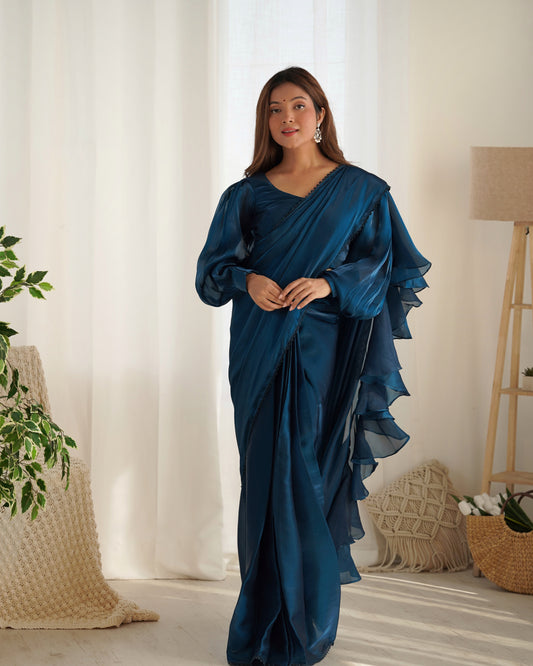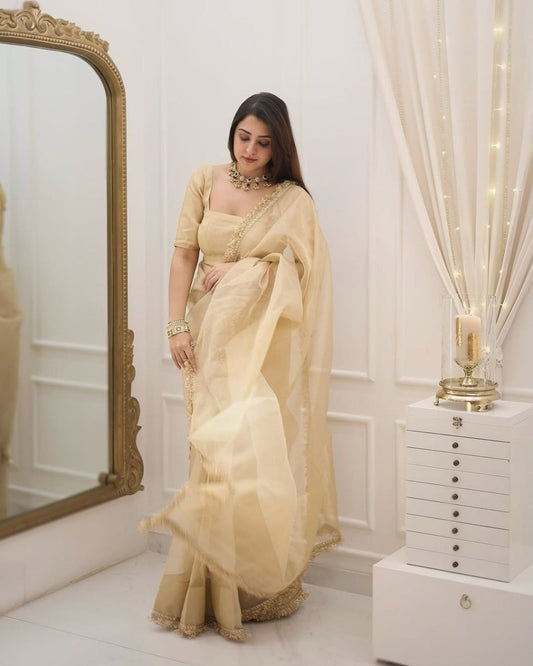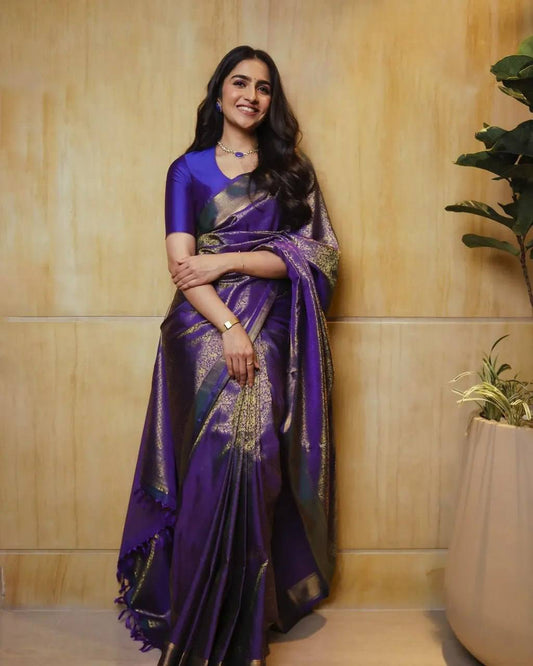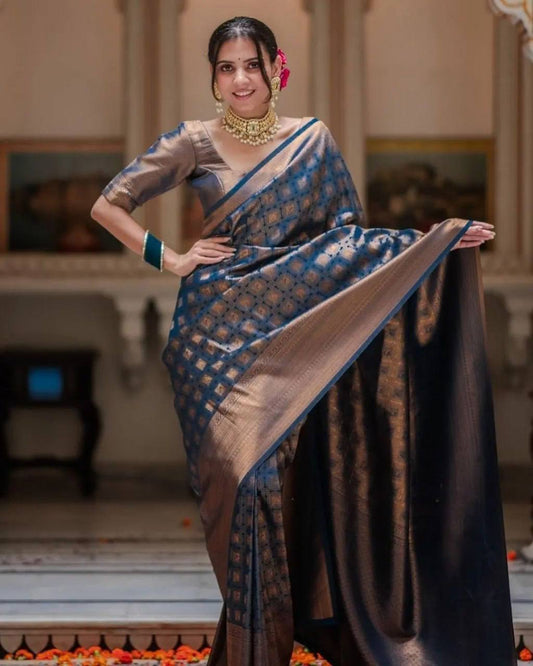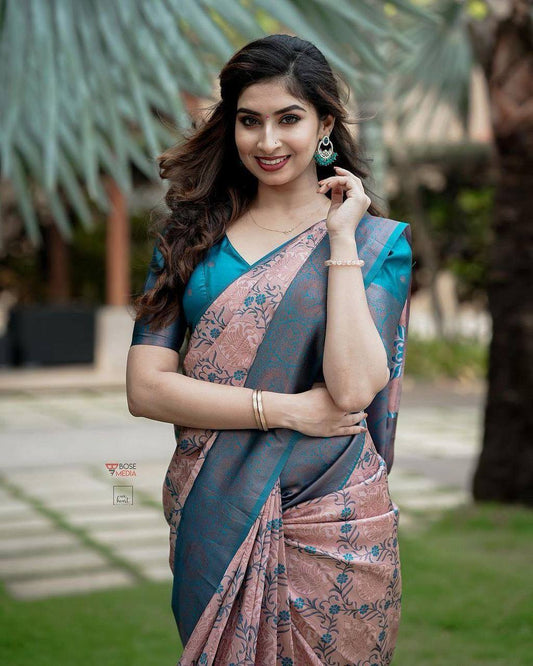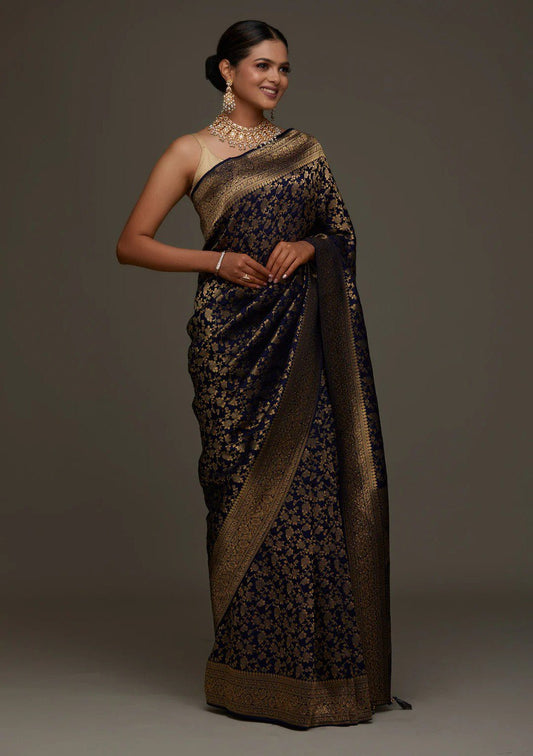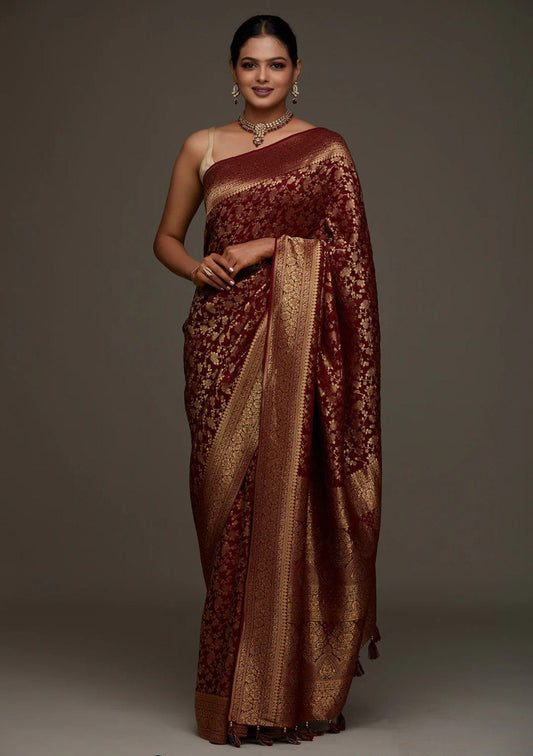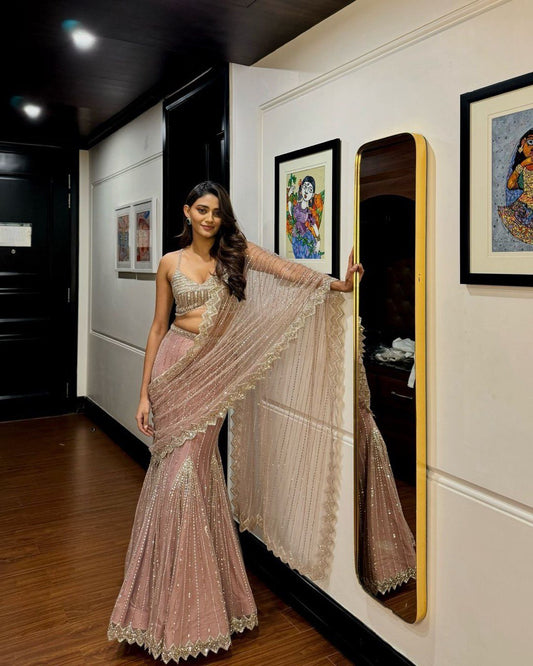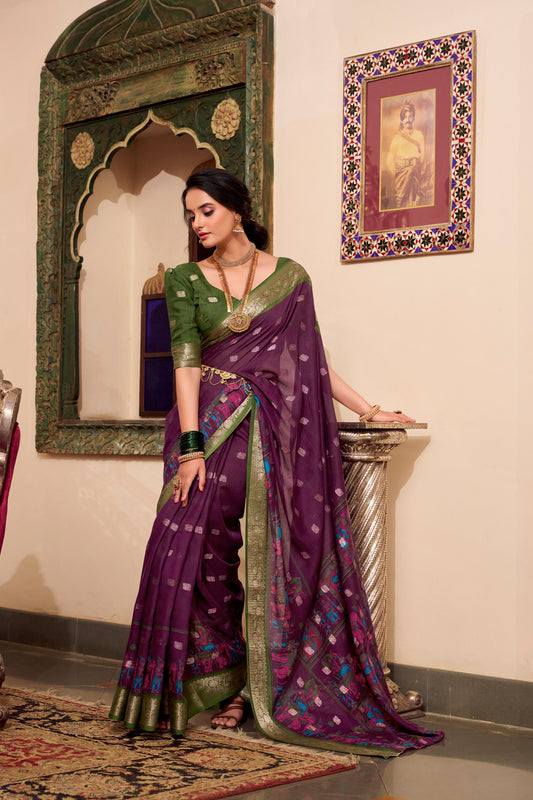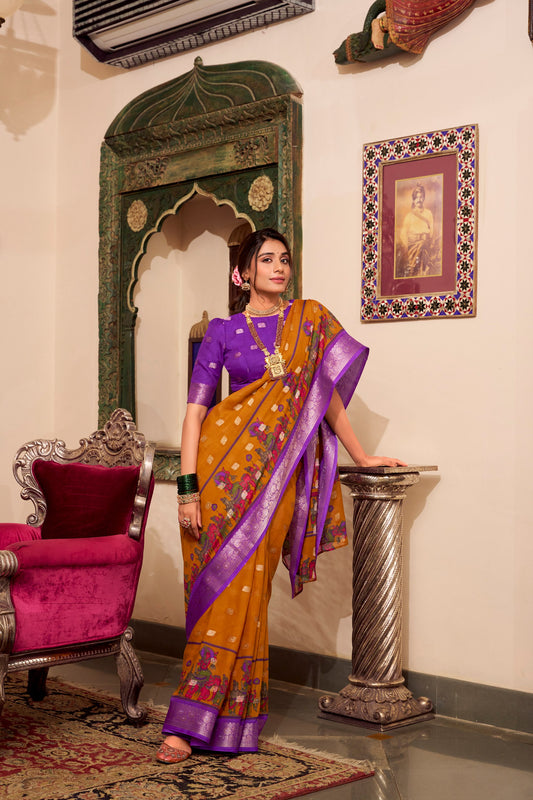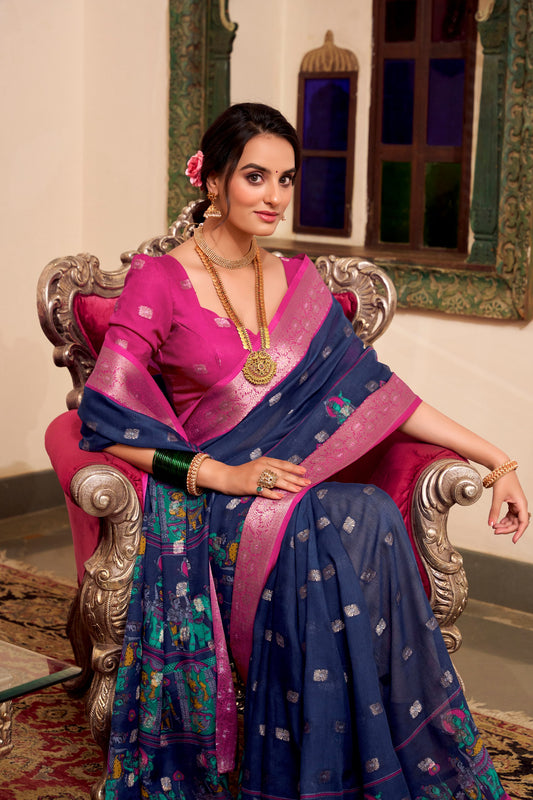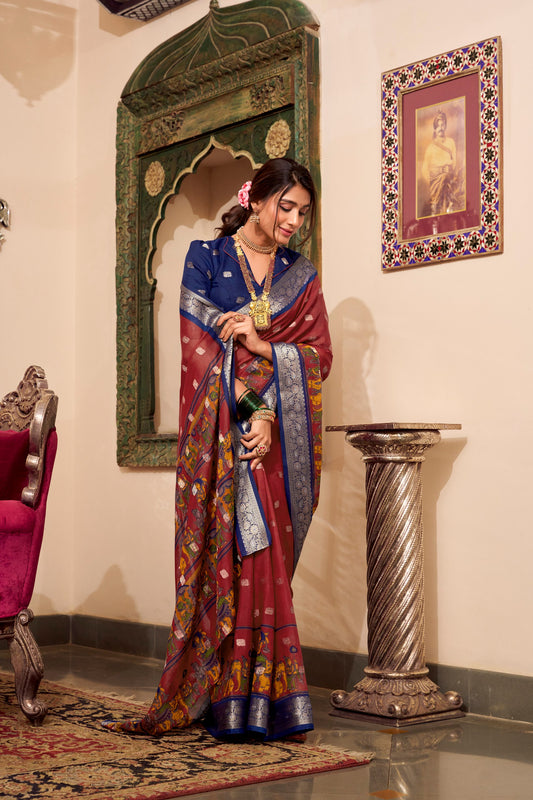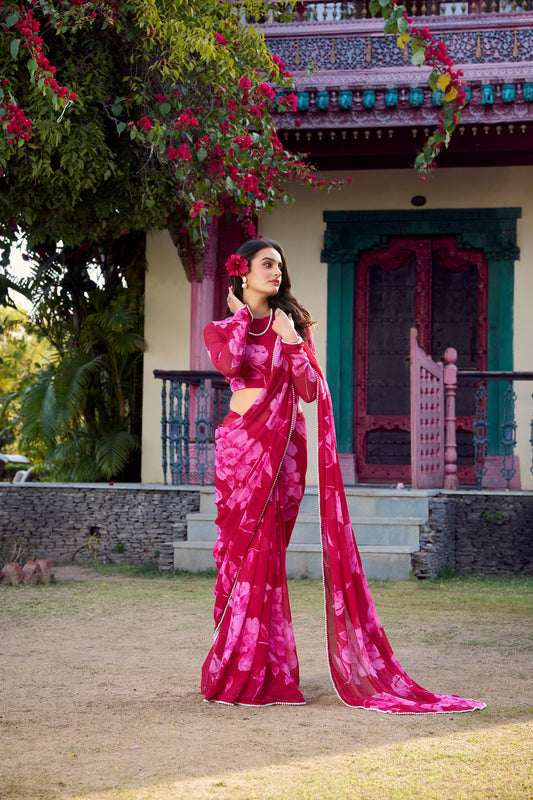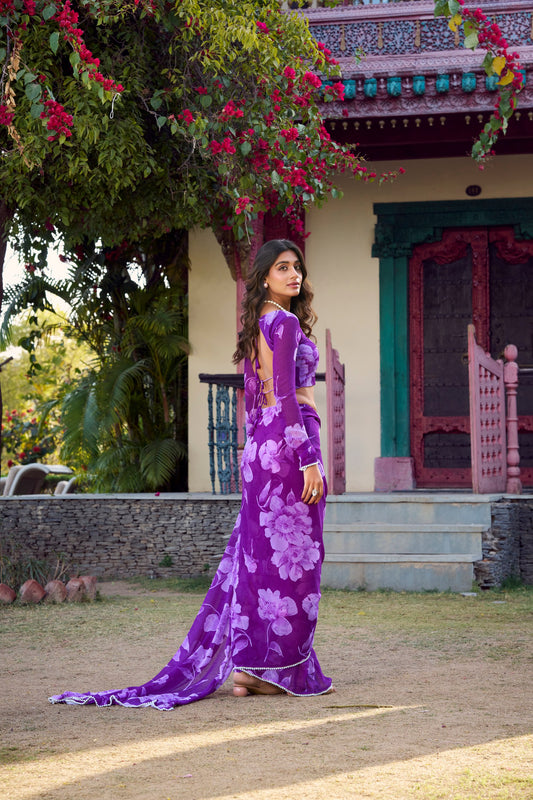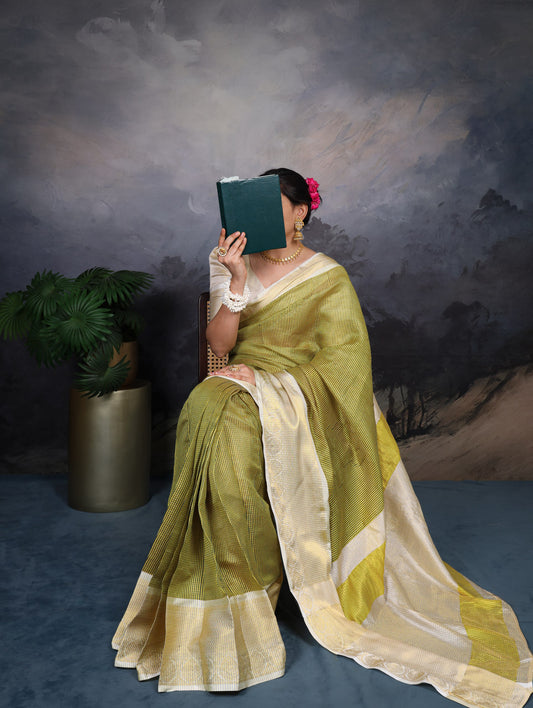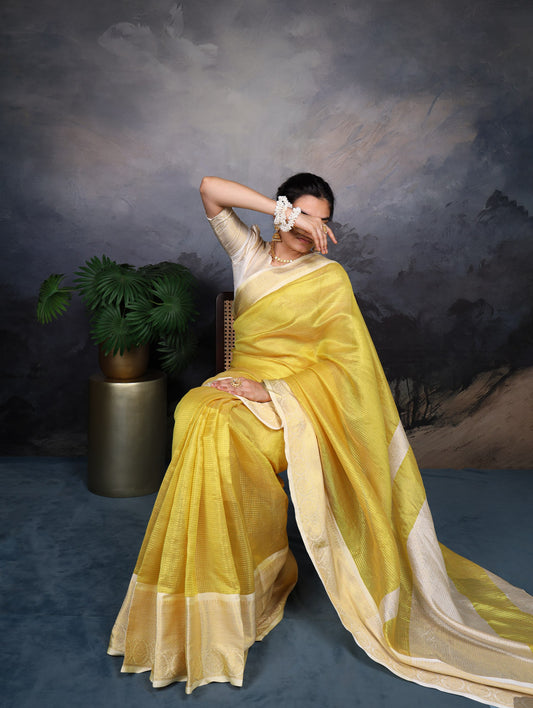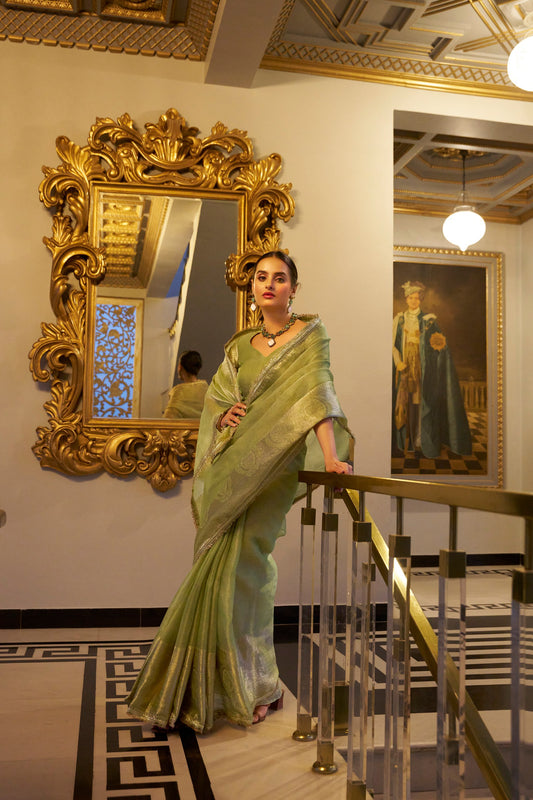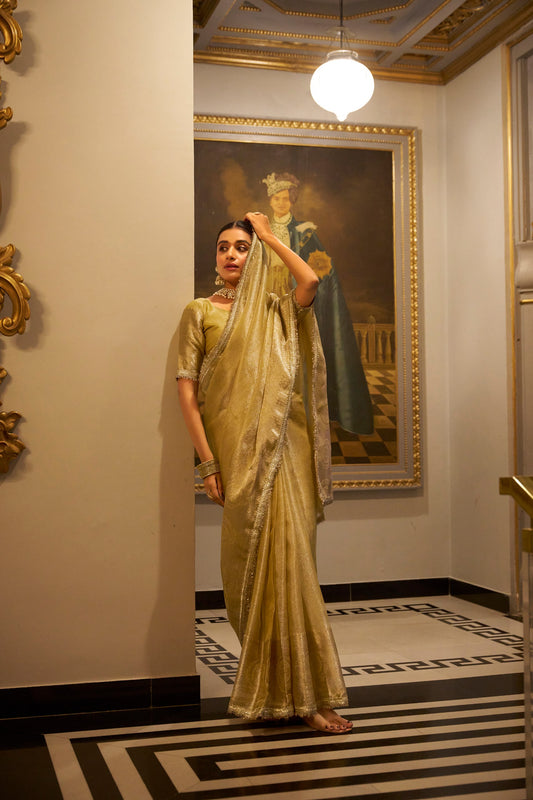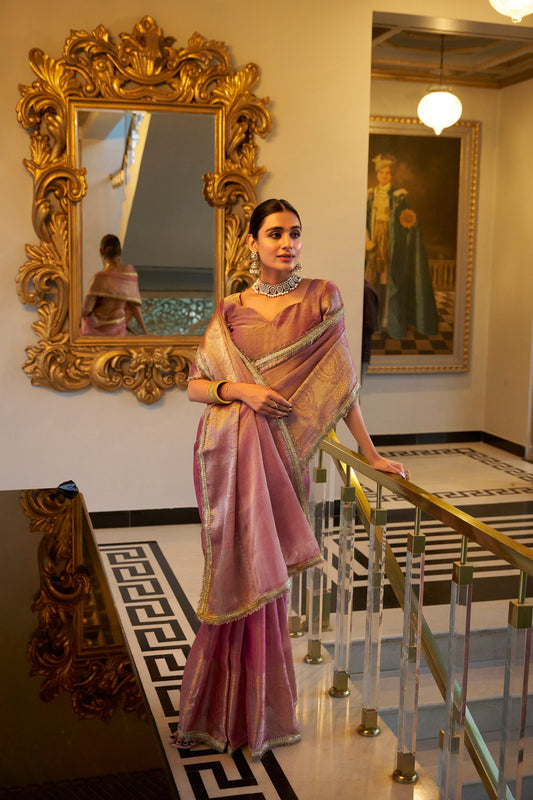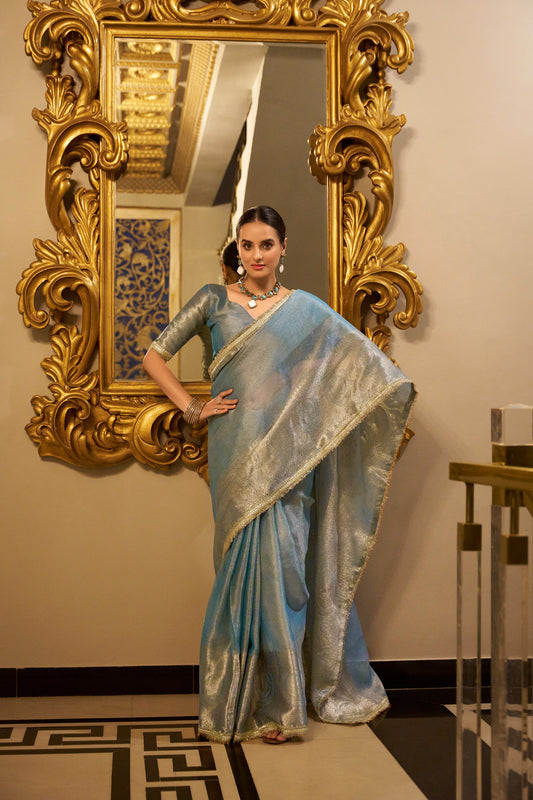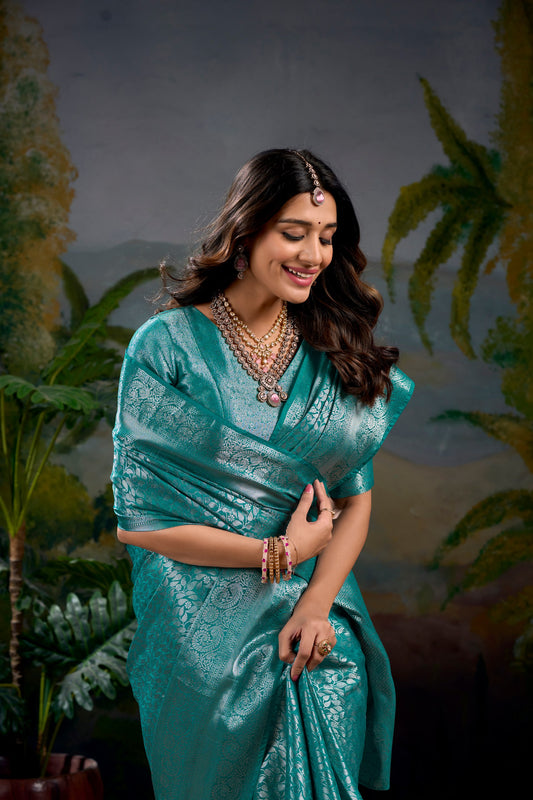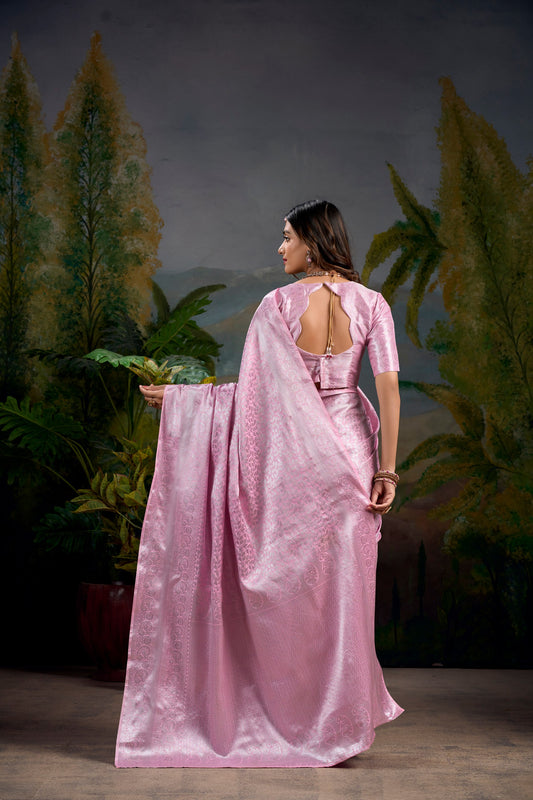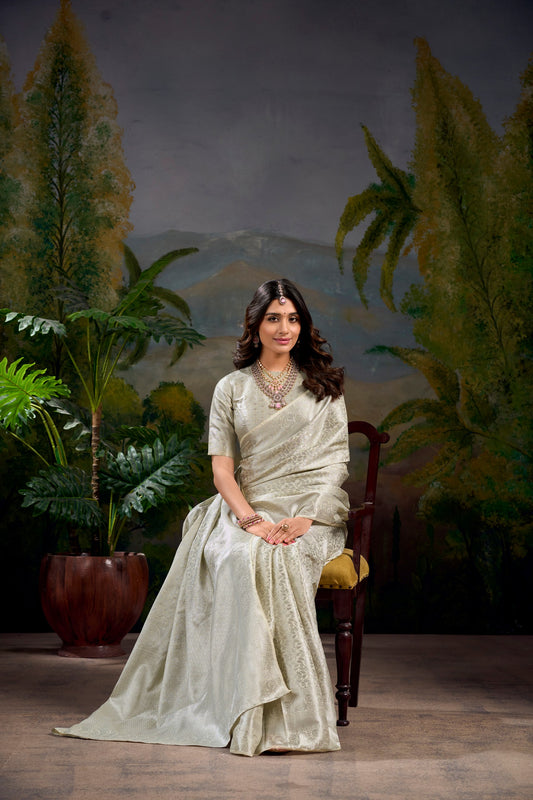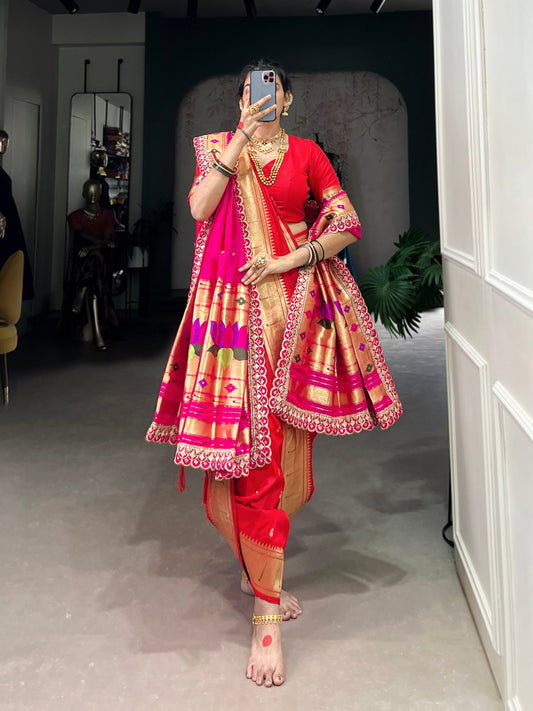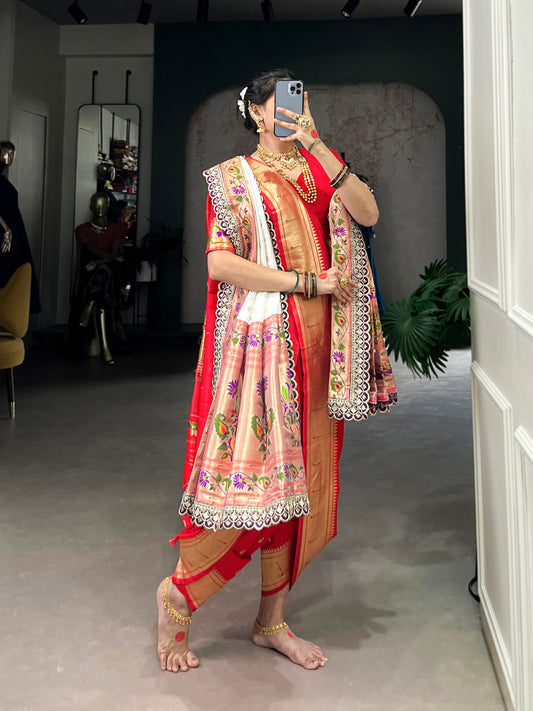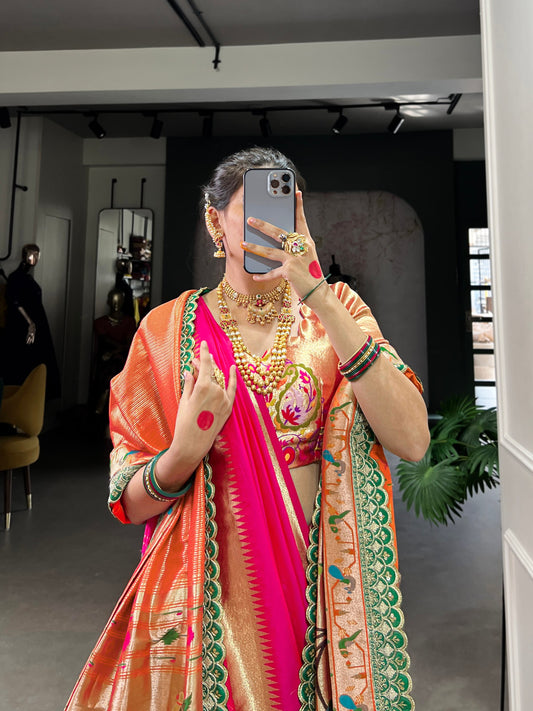-
Ruffle Style Orange Lehenga Saree in Faux Georgette with Sequins & Thread Work – Ready to Wear Ethnic Outfit
Regular price Rs. 2,249.00Regular priceUnit price / perRs. 3,999.00Sale price Rs. 2,249.00Sale -
Frill And Flare With Organza Silk Teal Blue Ruffle Border Saree
Regular price Rs. 2,099.00Regular priceUnit price / perRs. 2,999.00Sale price Rs. 2,099.00Sale -
Goldy Crazy Saree with Micro Inner and Matching Blouse
Regular price Rs. 1,799.00Regular priceUnit price / perRs. 3,599.00Sale price Rs. 1,799.00Sale -
Royal Blue Soft Lichi Silk Saree with Rich Pallu & Jacquard Work
Regular price Rs. 1,199.00Regular priceUnit price / perRs. 2,599.00Sale price Rs. 1,199.00Sale -
Soft Lichi Silk Blue Saree with Rich Pallu & Heavy Brocade Jacquard Blouse
Regular price Rs. 1,299.00Regular priceUnit price / perRs. 2,599.00Sale price Rs. 1,299.00Sale -
Soft Lichi Silk Peach Saree with Rich Pallu & All-Over Jacquard Work
Regular price Rs. 1,299.00Regular priceUnit price / perRs. 2,599.00Sale price Rs. 1,299.00Sale -
Banarasi Navy Blue Soft Silk Saree with Jacquard Border Blouse
Regular price Rs. 1,299.00Regular priceUnit price / perRs. 2,599.00Sale price Rs. 1,299.00Sale -
Banarasi Maroon Soft Silk Saree with Jacquard Border Blouse
Regular price Rs. 1,299.00Regular priceUnit price / perRs. 2,599.00Sale price Rs. 1,299.00Sale -
Soft Butterfly Net Lehenga Saree Set with Sequin Thread Work and Unstitched Choli
Regular price Rs. 2,499.00Regular priceUnit price / perRs. 4,999.00Sale price Rs. 2,499.00Sale -
Weightless Marbal Floral Printed Lavender Saree with Pearl Lace Border
Regular price Rs. 1,599.00Regular priceUnit price / perRs. 3,199.00Sale price Rs. 1,599.00Sale -
Weightless Marbal Floral Printed Pista Green Saree with Pearl Lace Border
Regular price Rs. 1,599.00Regular priceUnit price / perRs. 3,199.00Sale price Rs. 1,599.00Sale -
Weightless Marbal Floral Printed Sky Blue Saree with Pearl Lace Border
Regular price Rs. 1,599.00Regular priceUnit price / perRs. 3,199.00Sale price Rs. 1,599.00Sale -
Weightless Marbal Floral Printed Light Pink Saree with Pearl Lace Border
Regular price Rs. 1,599.00Regular priceUnit price / perRs. 3,199.00Sale price Rs. 1,599.00Sale -
Kalamkari Print Poly Cotton Wine Saree with Zari Weaving Work Border and Blouse
Regular price Rs. 1,699.00Regular priceUnit price / perRs. 3,399.00Sale price Rs. 1,699.00Sale -
Kalamkari Print Poly Cotton Yellow Saree with Zari Weaving Work Border and Blouse
Regular price Rs. 1,699.00Regular priceUnit price / perRs. 3,399.00Sale price Rs. 1,699.00Sale -
Kalamkari Print Poly Cotton Navy Blue Saree with Zari Weaving Work Border and Blouse
Regular price Rs. 1,699.00Regular priceUnit price / perRs. 3,399.00Sale price Rs. 1,699.00Sale -
Kalamkari Print Poly Cotton Saree with Zari Weaving Work Border and Unstitched Blouse
Regular price Rs. 1,699.00Regular priceUnit price / perRs. 3,399.00Sale price Rs. 1,699.00Sale -
Elegant Floral Printed Pink Chiffon Saree with Pearl Lace Border and Matching Blouse
Regular price Rs. 1,549.00Regular priceUnit price / perRs. 3,199.00Sale price Rs. 1,549.00Sale -
Elegant Floral Printed Purple Chiffon Saree with Pearl Lace Border and Matching Blouse
Regular price Rs. 1,549.00Regular priceUnit price / perRs. 3,199.00Sale price Rs. 1,549.00Sale -
Elegant Floral Printed Blue Chiffon Saree with Pearl Lace Border and Matching Blouse
Regular price Rs. 1,549.00Regular priceUnit price / perRs. 3,199.00Sale price Rs. 1,549.00Sale -
Jacquard Chex Green Saree with Zari Weaving and Unstitched Blouse
Regular price Rs. 1,499.00Regular priceUnit price / perRs. 2,999.00Sale price Rs. 1,499.00Sale -
Jacquard Chex Yellow Saree with Zari Weaving and Unstitched Blouse
Regular price Rs. 1,499.00Regular priceUnit price / perRs. 2,999.00Sale price Rs. 1,499.00Sale -
Tissue Shimmer Pista Green Saree with Zari Weaving and Sequins Lace Border
Regular price Rs. 1,649.00Regular priceUnit price / perRs. 3,299.00Sale price Rs. 1,649.00Sale -
Tissue Shimmer Gold Saree with Zari Weaving and Sequins Lace Border
Regular price Rs. 1,649.00Regular priceUnit price / perRs. 3,299.00Sale price Rs. 1,649.00Sale -
Tissue Shimmer Light Pink Saree with Zari Weaving and Sequins Lace Border
Regular price Rs. 1,649.00Regular priceUnit price / perRs. 3,299.00Sale price Rs. 1,649.00Sale -
Tissue Shimmer Sky Blue Saree with Zari Weaving and Sequins Lace Border
Regular price Rs. 1,649.00Regular priceUnit price / perRs. 3,299.00Sale price Rs. 1,649.00Sale -
Elegant Weightless Marble Printed Blue Saree with Pearl Lace Border | Lightweight Designer Saree for Women
Regular price Rs. 1,549.00Regular priceUnit price / perRs. 2,999.00Sale price Rs. 1,549.00Sale -
Elegant Weightless Marble Printed Red Saree with Pearl Lace Border | Lightweight Designer Saree for Women
Regular price Rs. 1,549.00Regular priceUnit price / perRs. 2,999.00Sale price Rs. 1,549.00Sale -
Elegant Weightless Marble Printed Purple Saree with Pearl Lace Border | Lightweight Designer Saree for Women
Regular price Rs. 1,549.00Regular priceUnit price / perRs. 2,999.00Sale price Rs. 1,549.00Sale -
Elegant Weightless Marble Printed Mehendi Green Saree with Pearl Lace Border | Lightweight Designer Saree for Women
Regular price Rs. 1,549.00Regular priceUnit price / perRs. 2,999.00Sale price Rs. 1,549.00Sale -
Elegant Kanjivaram Silk Bottle Green Saree with Zari Weaving Work | Traditional Ethnic Wear for Weddings and Festivals
Regular price Rs. 1,599.00Regular priceUnit price / perRs. 2,999.00Sale price Rs. 1,599.00Sale -
Elegant Kanjivaram Silk Pink Saree with Zari Weaving Work | Traditional Ethnic Wear for Weddings and Festivals
Regular price Rs. 1,599.00Regular priceUnit price / perRs. 2,999.00Sale price Rs. 1,599.00Sale -
Elegant Kanjivaram Silk White Saree with Zari Weaving Work | Traditional Ethnic Wear for Weddings and Festivals
Regular price Rs. 1,599.00Regular priceUnit price / perRs. 2,999.00Sale price Rs. 1,599.00Sale -
Premium Jacquard Silk Paithani Zari Weaving Red Saree Set with Dupatta | Traditional Ethnic Wear
Regular price From Rs. 1,999.00Regular priceUnit price / per -
Premium Jacquard Silk Paithani Zari Weaving Red Saree Set with Dupatta | Traditional Ethnic Wear
Regular price From Rs. 1,999.00Regular priceUnit price / per -
Premium Jacquard Silk Paithani Zari Weaving Pink Saree Set with Dupatta | Traditional Ethnic Wear
Regular price From Rs. 1,999.00Regular priceUnit price / per
Collection: Saree
Sarees: A Deep Dive into History, Styles, and Draping Techniques
The saree (also known as sari, shari, or occasionally misspelled as saree) is a traditional women's garment that originates from the Indian Subcontinent. It is a versatile and timeless piece of clothing, typically worn by women in India, Pakistan, Bangladesh, Sri Lanka, and Nepal. The saree is an unstitched piece of cloth, usually ranging from 4.5 to 9 meters (15 to 30 feet) in length and 600 to 1,200 millimeters (24 to 47 inches) in width. The fabric is draped around the waist, with one end styled over the shoulder, leaving the midriff exposed. This elegant garment is often paired with a blouse (called choli in many parts of India) and a petticoat.
The saree holds immense cultural significance and is considered a symbol of grace and elegance, making it an iconic piece of attire in South Asia. Over the centuries, it has evolved from being a simple strip of cloth to a refined piece of craftsmanship, revered globally for its versatility and beauty.
Origins and Evolution of the Saree
The word sari is derived from the Sanskrit word shati, which translates to "strip of cloth." The evolution of the saree dates back to the Indus Valley Civilization (2800-1800 BCE), where early versions of draped clothing were worn. Cotton was first cultivated and woven in the Indian subcontinent around the 5th millennium BCE, and silk was introduced around 2450 BCE. The art of dyeing fabrics, particularly using indigo, lac, turmeric, and red madder, is still practiced today.
The sari evolved from the ancient poshak, a three-piece ensemble consisting of:
- Antariya (the lower garment),
- Uttariya (the upper veil),
- Stanapatta (the chestband).
By the 1st century CE, the stanapatta evolved into the modern choli or blouse, marking a key milestone in the evolution of the saree.
Traditional Saree Fabrics and Types
The saree is often crafted from luxurious fabrics, such as silk, cotton, velvet, and chiffon. The following are some of the most popular types of sarees, each representing a region’s rich heritage:
- Banarasi Silk: Known for its intricate brocade work, ideal for weddings and formal events.
- Kanchipuram Silk: A staple for brides, made with luxurious silk and exquisite zari work.
- Paithani: Originating from Maharashtra, known for its rich silks and elaborate borders.
- Mysore Silk: A soft and shiny fabric often worn at festivals and special occasions.
- Chanderi: Lightweight silk with golden zari, perfect for summers and day events.
- Tussar Silk: Known for its rich texture and earthy tones.
- Cotton Sarees: Ideal for casual and everyday wear, popular in regions like Kolkata, Bengal, and Tamil Nadu.
- Patola and Ikat: Known for their handwoven craftsmanship and vibrant patterns.
Popular Saree Styles and Draping Techniques
There are numerous styles of draping a saree, each reflecting the traditions of a specific region. Here are some of the most famous saree draping styles:
- Nivi Style: The most common style, worn across India, where the saree is wrapped around the waist and draped over the shoulder.
- Bengali & Odia Style: The saree is draped with a pleated look at the front, and the pallu (loose end) is thrown over the shoulder.
- Gujarati/Rajasthani Style: This style features pleats in the front and the pallu draped over the left shoulder.
- Maharashtrian Style (Nav-vari): Known for its unique drape, where the saree is worn like a dhoti.
- Kerala Style: Also called Mundum Neriyathum, this drape is traditional to Kerala and involves a simple wrap-around without pleats.
- Madisar Style: Popular in Tamil Nadu, this draping style involves wrapping the saree in a manner similar to a dhoti.
- Mekhela Chadar Style: Traditional in Assam, it includes two parts - the mekhela (lower garment) and the chadar (upper drape).
- Nepali Style: A variation where the saree is draped similar to the Nivi style but with some regional twists.
Other regional variations include the Pin Kosuvam, Brahmika style, Kodagu style, and Tribal Indigenous Styles, reflecting the diverse cultural heritage of South Asia.
Saree Fabrics and Regional Embroidery
Sarees are made from a variety of regional handloom fabrics:
- Brocade Silk: Popular in Banaras, Kanchipuram, and Mysore.
- Ikat & Patola: Known for their hand-dyed, intricate patterns from Gujarat and Odisha.
- Tussar Silk: Known for its earthy tones and durable texture.
- Kalamkari: A form of hand-painted or block-printed saree, often featuring mythological themes.
- Bandhani: Traditional tie-dye fabric from Rajasthan and Gujarat.
- Gota Patti: Embroidery that adds a rich texture and is commonly used on wedding sarees.
Regional Names for Saree
The word saree is known by different names across the Indian subcontinent, such as শাৰী in Assamese, শাড়ি in Bengali, સાડી in Gujarati, साड़ी in Hindi, ಸೀರೆ in Kannada, സാരി in Malayalam, साडी in Marathi, सारी in Nepali, ଶାଢ଼ୀ in Odia, ਸਾਰੀ in Punjabi, புடவை in Tamil, చీర in Telugu, and ساڑى in Urdu.
The saree is much more than just a garment—it's a symbol of heritage, culture, and elegance. From its ancient roots in the Indus Valley Civilization to its evolution in modern India, the saree continues to be cherished as one of the most iconic and versatile outfits for women. With its countless draping styles, fabrics, and regional variations, the saree allows every woman to express her individuality and heritage with grace.
Whether you are attending a wedding, festival, or special event, the saree is the epitome of timeless beauty. Embrace its rich history, and experience the grace and charm of wearing one today.




